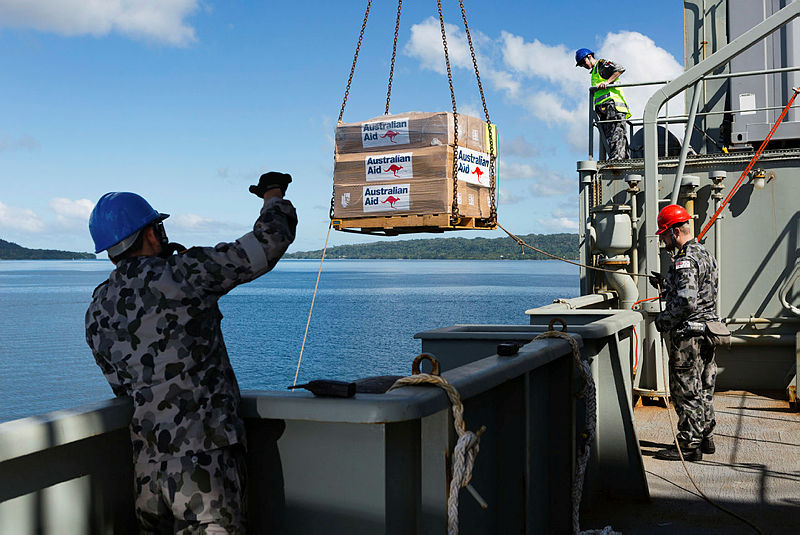
If you were trying to design a low-cost strategy to constrict the operational horizon of an important US ally in the region, China’s ploys in the Pacific wouldn’t be a bad model to examine.
China has been talking a big game in the Pacific. It’s been reported as looking to fund a major regional military base in Fiji and scoping Vanuatu for a military base of its own. And it apparently has plans to refurbish four ports in Papua New Guinea, including the strategically significant Manus Island. Over the decade 2006–2016, it has committed US$1.8 billion in aid, and Chinese telco Huawei has sought to build undersea internet cables in the region.
Australia’s response has been frenzied, but perhaps not yet that strategic.
Our aid spending in the South Pacific has been hurriedly increased from A$1.1 billion in 2017–18 to A$1.3 billion in 2018-19, the ‘highest ever contribution’ we’ve made in the region. Australia had to outbid China for the Fiji base, investing a ‘significant’ figure.
The Department of Foreign Affairs and Trade has also dipped its toes into the undersea cabling business, assembling a crack team to master the ins and outs of a new underwater operating environment. The project has an estimated price tag of A$136.6 million (two-thirds of which will come from the aid budget). There has also been a deal to expand the Biketawa security agreement to cover non-traditional threats.
That all fits in with the 2017 foreign policy white paper’s promise of ‘greater intensity and ambition’ in Australia’s approach to its neighbourhood. But is it good strategy?
Increasingly, China’s approach in the Pacific looks like its coercive methods in the Australia–China economic relationship, where sectors of little importance to the Chinese Communist Party but of significant value to Australia—like Chinese students and tourists—are used to try to coerce Canberra.
In the Pacific, China appears to have identified our soft spots and now just has to hint at scoping a port to cause a frenzy. Its debt diplomacy is another lever with dual purposes. It wins China temporary kudos in Pacific states, while simultaneously countering Canberra’s aspirations of improving Pacific development by saddling tiny island nations with unaffordable loans. When the debts become crippling, they will afford Beijing another opportunity to niggle Canberra by offering debt relief in return for something that will frustrate Australian plans, or inflict the burden of debt relief on Australia.
Undersea cables are just the latest front and present another opportunity for China to divert significant Australian resources, without spending any of its own. China, if it wanted to, could offer to build a dozen cables linking up the region. Would Australia then rush to spend hundreds of millions more to build those connections too?
At one level, Canberra’s response is completely understandable, as Australia’s top priority is protecting its immediate region and preventing it from becoming a site for a major military power to operate from. But is the current approach the most efficient use of our resources? And in the longer term, do we risk constricting our operational horizon, shifting from engaging both globally and regionally—where we participate as an international actor and at least periodically consider actions like freedom-of-navigation exercises in the South China Sea—to being more narrowly focused on our immediate neighbourhood? That would be a win for China and a loss for the world.
China’s actions in the South China Sea, the militarisation of its manufactured islands and its threatening behaviour towards its neighbours, do not bode well. If it eventually has its way in its immediate patch, it will almost certainly look to expand its operational space further afield. Australia’s focus and actions with partners in the broader region are a valuable contribution to dealing with this more assertive, at times coercive, Chinese state led by President Xi Jinping.
To deal with this Pacific challenge in a more enduring way, could Canberra look to a bigger play? A plan for addressing China’s attempts to militarise the region, cripple it with debt and force DFAT to become a telecommunications provider?
One option would be for Australia to forge a grand bargain with its neighbours—a sweeping economic, education, people-movement and security pact that prevents the militarisation of the Pacific and allows Australia to remain outwardly oriented. We could establish a regional security council to work towards common approaches on issues like debt diplomacy, protection of critical infrastructure and climate change, with phase-in periods to allow for a smooth transition.

